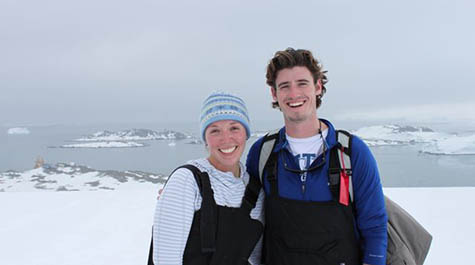Students conduct research in Antarctica
Virginia Institute of Marine Science graduate student Patricia Thibodeau and William & Mary undergraduate Jack Conroy are currently conducting field research in Antarctica thanks in part to a generous gift from Adrian G. “Casey” Duplantier Jr. and 1st Advantage Federal Credit Union of Newport News.
The two students are a part of a team of researchers led by VIMS Professor Deborah Steinberg who make the annual six-week trip to Antarctica aboard the research vessel Laurence M. Gould. The team left Virginia in late December and will return in mid-February, taking advantage of the brief polar summer to conduct their research.
The team’s current expedition is part of the Long-Term Ecological Research program at the U.S. Palmer Research Station on Anvers Island. The PAL-LTER program is headed by former VIMS professor Hugh Ducklow, and funded through a competitive grant from the National Science Foundation.
Each year, the VIMS team collects zooplankton at a series of sampling stations in the waters along the west coast of the Antarctic Peninsula to better understand how climate change is affecting the microscopic animals that form the base of the Antarctic food web.
"We're interested in zooplankton for two main reasons," says Steinberg. "First, changes in their abundance and species composition ripple up the food chain to affect fish, penguins, and whales. Second, they play an important role in the ‘biological pump,' potentially helping to move carbon dioxide from the atmosphere into the deep sea where it doesn't contribute to global warming."
Thibodeau says her participation in PAL-LTER has opened the door to many research opportunities and questions, which is exciting for her as an up-and-coming scientist. A first-year graduate student in Steinberg’s Zooplankton Laboratory at VIMS, Thibodeau is still developing the focus of her graduate research, but says she would like to study pteropods, a group of snails and slugs that have adapted to a free-swimming life in the open ocean. These organisms—an important part of the marine food web—are particularly vulnerable to the ocean acidification that comes with rising levels of carbon dioxide in seawater.
During the current expedition, Thibodeau is helping to identify the types of zooplankton captured in nets towed at different sampling stations. “I assist in experiments conducted on krill and salps, specifically filtering water for chlorophyll to determine primary productivity, and filtering water from fecal-pellet experiments to identify the carbon content produced from krill and salps over a specific period of time,” she says.
In addition to her own gratitude for the Duplantier/1st Advantage support, Thibodeau says she is also grateful that it gave the team the opportunity to bring Conroy along with them. “Having a W&M undergraduate join the lab provides depth and a new perspective on our research that wouldn’t have existed otherwise,” she says.
Conroy says the expedition has been an incredible experience, and that the opportunity to rub shoulders with so many amazing scientists has been just as memorable as the stunningly beautiful sights he has seen so far. “I’m just trying to be a sponge and soak in as much advice as I can from everyone aboard the ship,” he says. “Meeting so many wonderful people on my first immersion into scientific field work encourages me to consider ways to stay involved in this type of research now that Dr. Steinberg and Mr. Duplantier have helped me get my foot in the door.”
Annual winter temperatures along the Antarctic Peninsula have increased by 11°F during the last 50 years, five times the global average warming. Researchers with the Palmer LTER program have monitored this change since 1991, and are now focusing their studies on how the rapidly warming climate is affecting sea ice and marine creatures in the region. In the 35 years since researchers first started counting Adélie penguins in the area, the number of breeding pairs has declined from around 35,000 to 5,600, a drop of more than 80 per cent.
The Duplantier/1st Advantage gift has allowed one VIMS graduate student and one W&M undergraduate to conduct research at Palmer each year since 2007. Previous gift recipients are VIMS graduate students Josh Stone, Lori Price, Kate Ruck, Glaucia Fragoso, Heidi Geisz, and Noelle Yochum; and W&M undergrads Domi Paxton, Caitlin Smoot, Sarah Giltz, Miram Gleiber, Erin Morgan, and Julian Ma.
“I’m excited to sponsor young students interested in pursuing a career in the marine bio-environmental field,” says Duplantier. “VIMS and W&M attract talented students who will make a difference discovering and finding solutions to rapidly changing environmental conditions.”
The Palmer LTER is one of more 26 LTER research sites located throughout the United States and its territories; each focused on a specific ecosystem. The Palmer LTER studies a polar marine biome with research focused on the Antarctic pelagic marine ecosystem, including sea ice habitats, regional oceanography and terrestrial nesting sites of seabird predators.

















